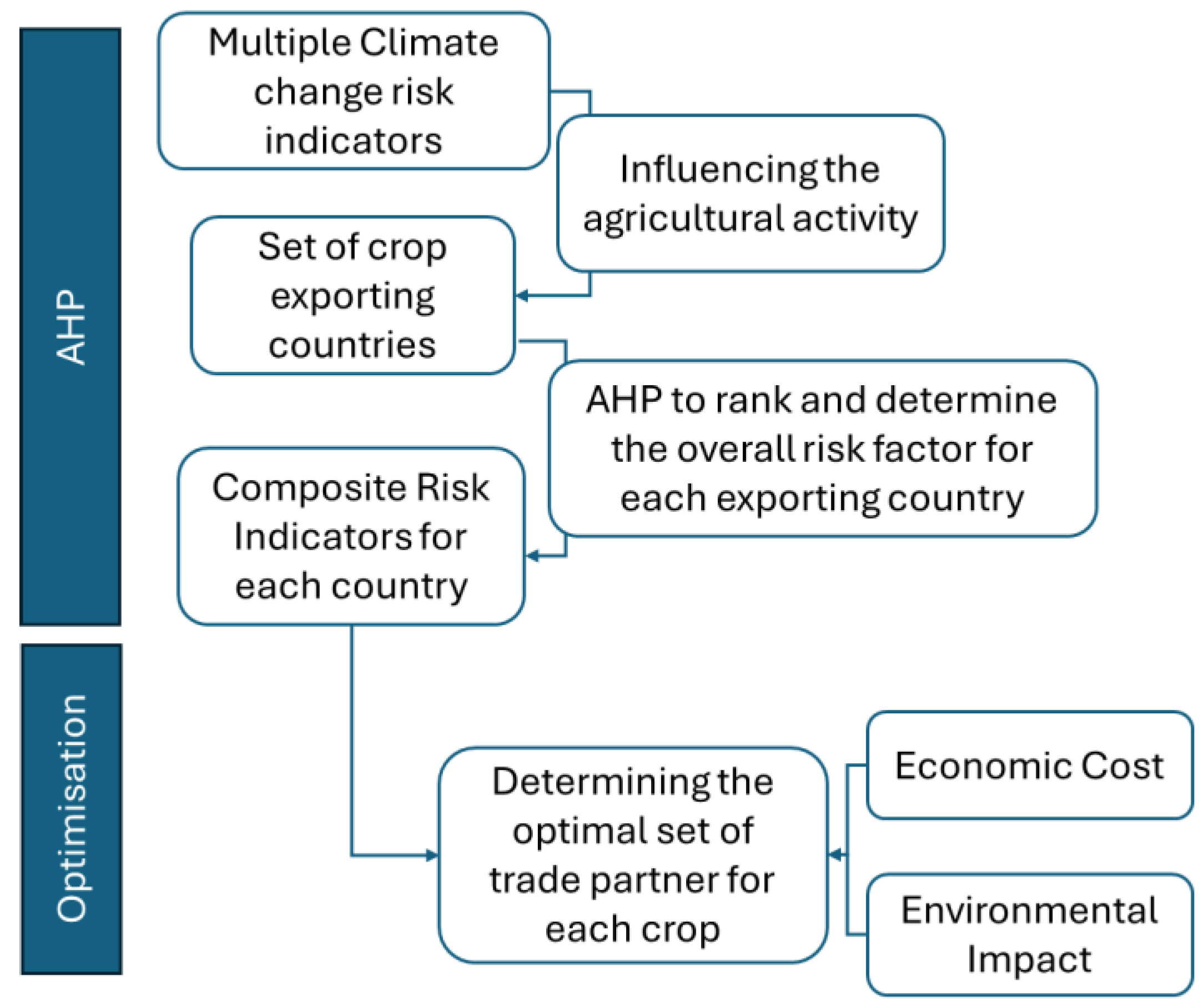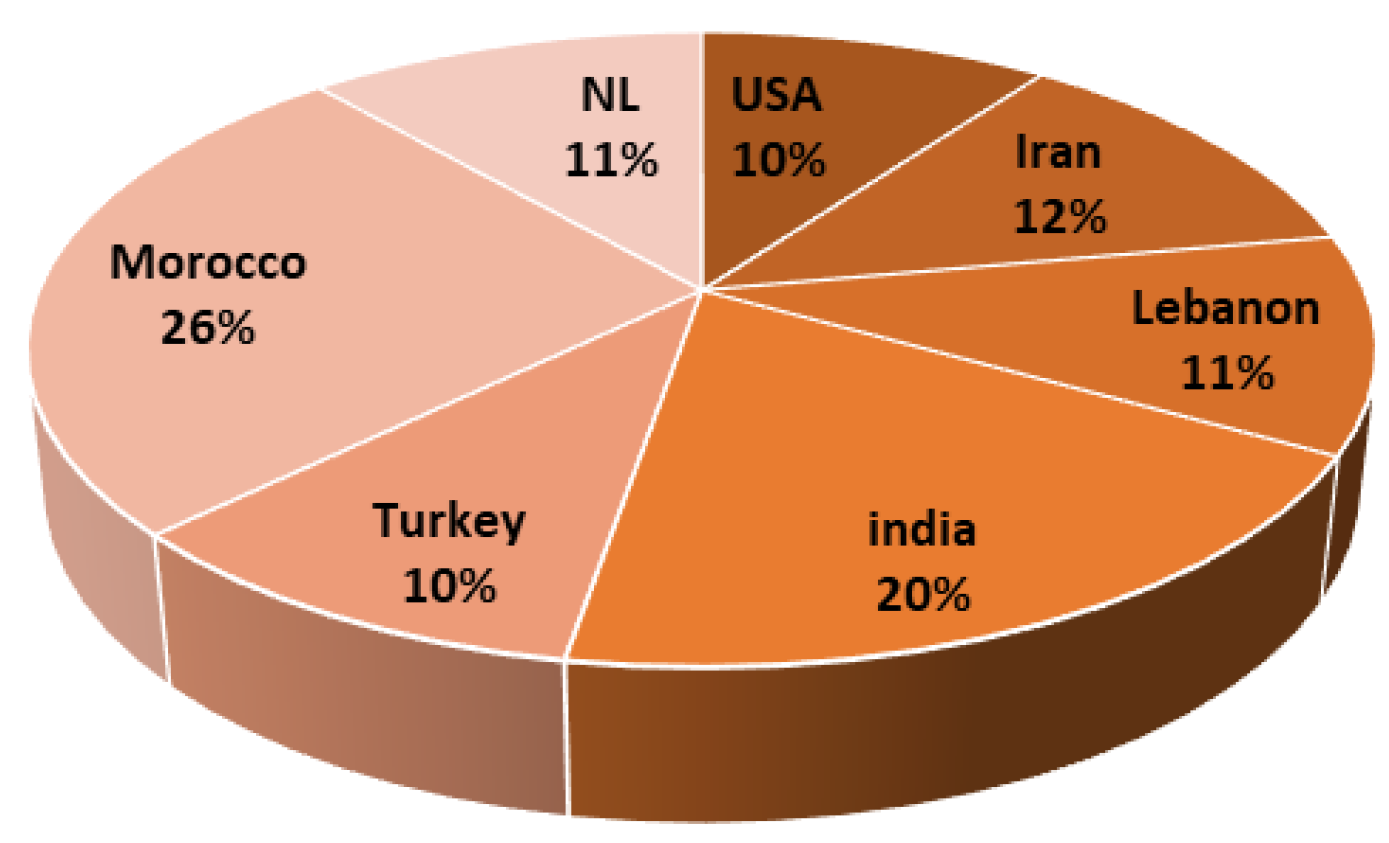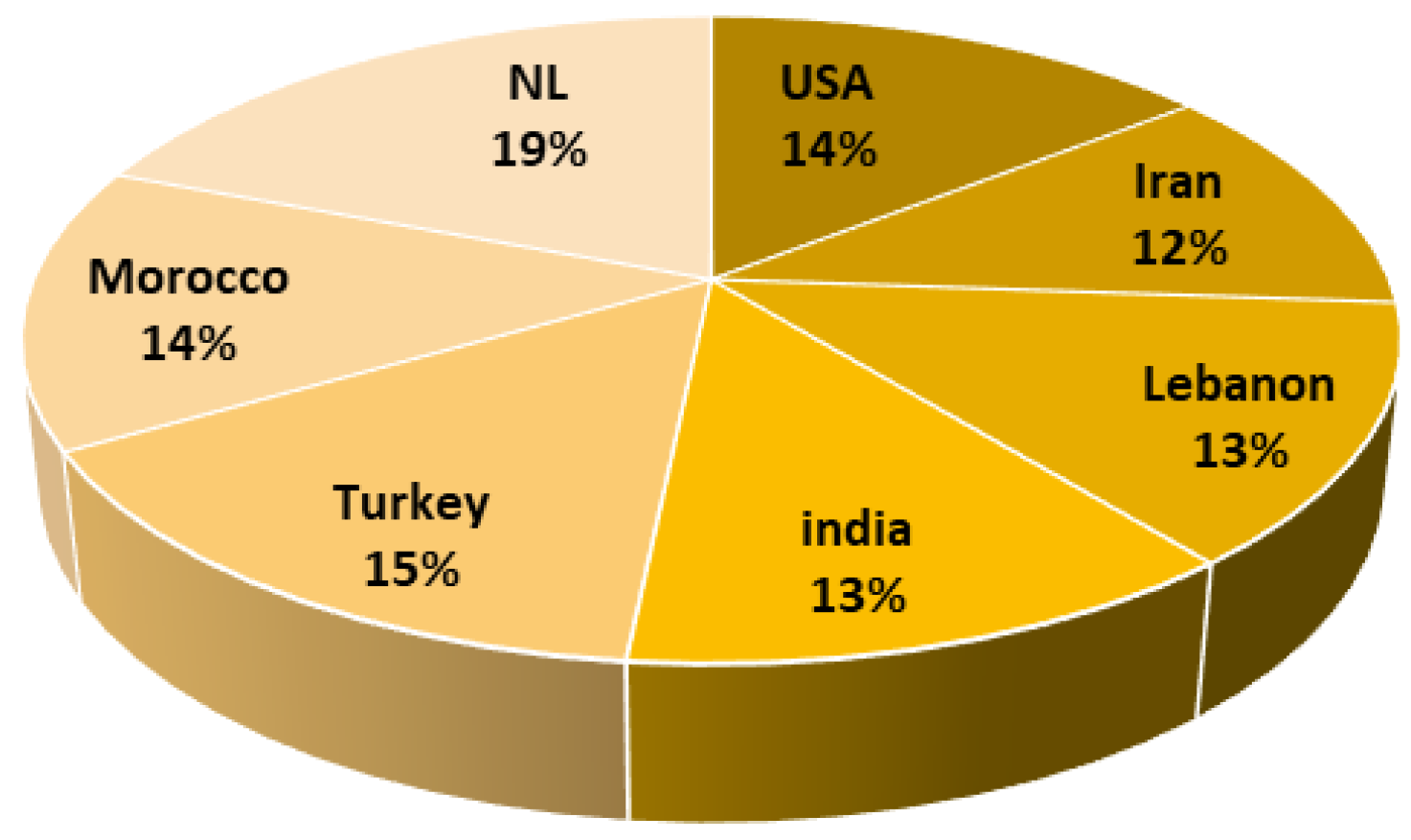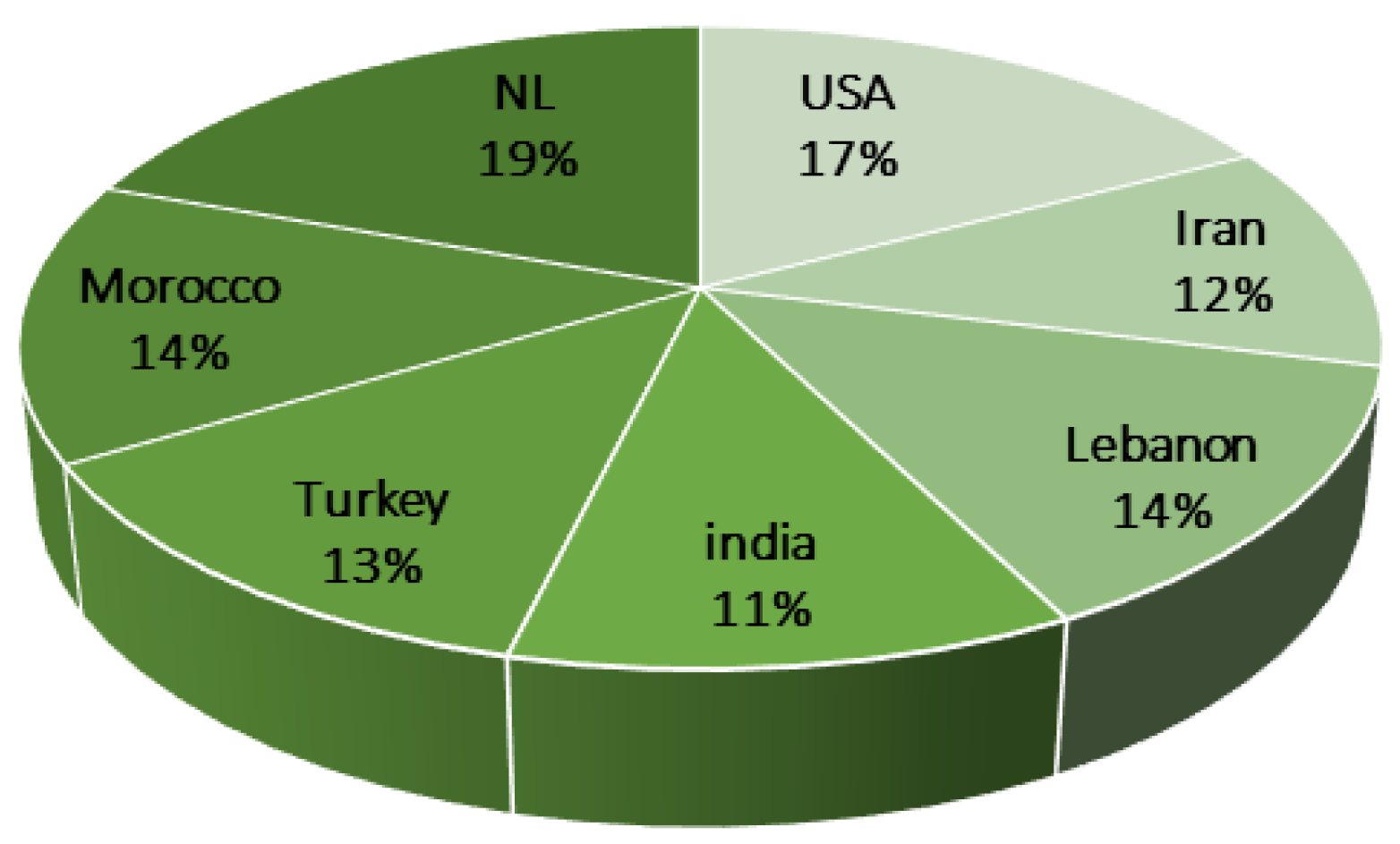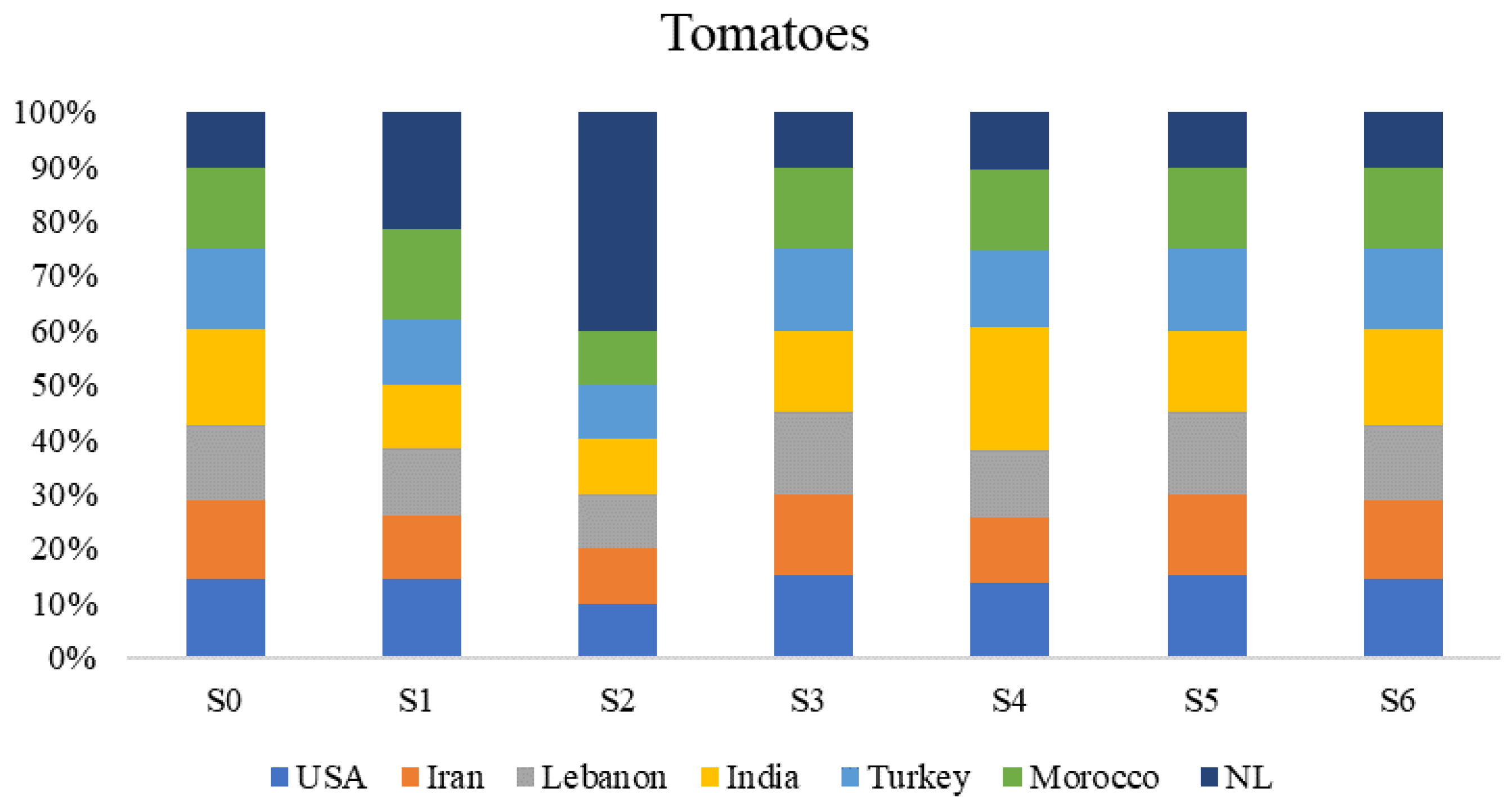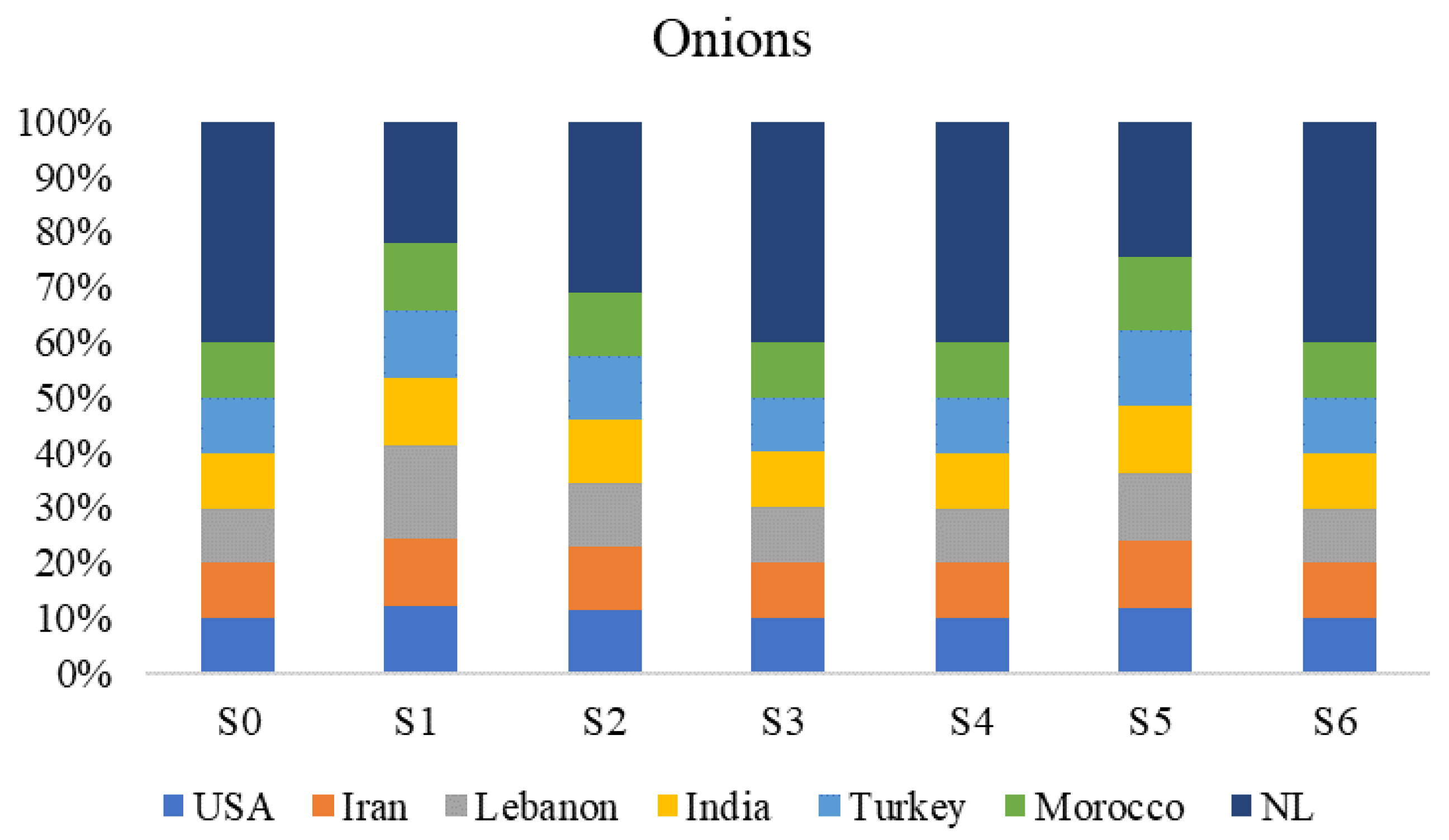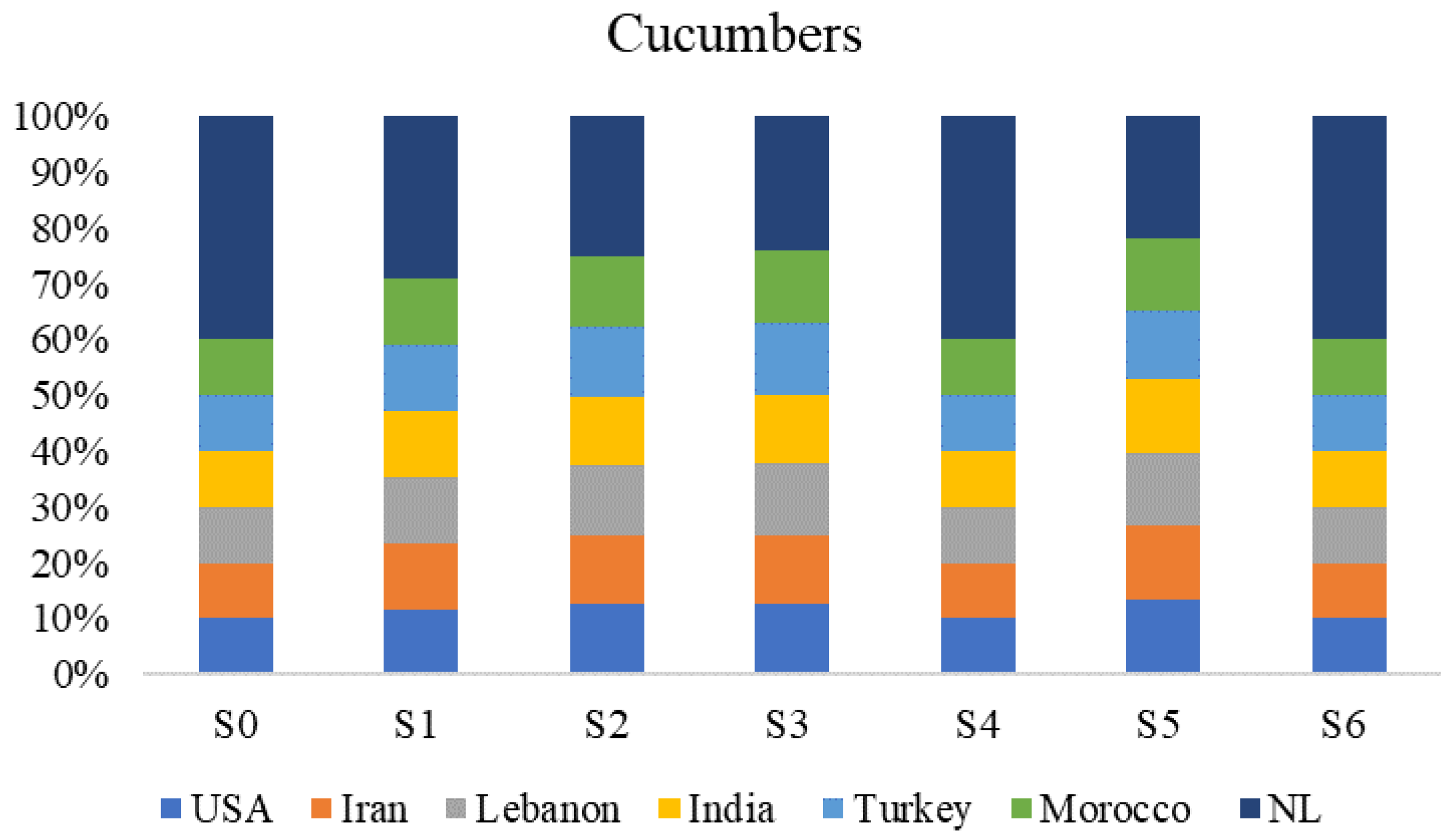1. Introduction
Climate change stands as one of the foremost global challenges, markedly affecting Earth’s ecosystems. While fluctuations in climate have been constant over the past century, the pace of change has accelerated notably in recent decades. Human activities since the 19th century have led to a 0.9 °C increase in the average global temperature, due to the emission of greenhouse gases (GHGs). Projected trends suggest that with ongoing deforestation and pollution of air, soil, and water, this warming could reach 1.5 °C by 2050 [
1]. Shifts in temperature and precipitation over time are reshaping the global distribution of food production advantages, potentially hindering agricultural productivity growth in regions already struggling with hunger. These changes threaten to disrupt global agriculture and food systems, leading to yearly fluctuations in food availability. If current climate trends continue, there could be unparalleled increases in crop failures, leading to decreased production, higher food prices, and challenges in meeting the growing demand.
Given that food systems are vulnerable to the impacts of climate change and natural disasters, the consequences of these factors can manifest either abruptly or gradually, leading to either favorable or adverse outcomes [
1]. Notably, these impacts primarily affect the production stages, accounting for approximately 20% of the entire value chain [
2]. Furthermore, global agricultural markets have become increasingly complex due to a heightened focus on food standards related to safety, quality, and technological advancements. These factors drive changes throughout the industry, affecting the entire value chain. These complexities intensify the challenge of establishing a resilient and robust food supply system. Therefore, it becomes important to adopt a holistic approach, considering the entire value chain rather than solely focusing on the production stage [
3]. Therefore, there is a growing need to enhance efforts linked to identifying and classifying risks associated with food systems, exploring data from various segments of the value chain. Consequently, the main objective of this study is to evaluate the climate change risk of seven different suppliers for three different crops from the importer’s viewpoint.
In this study, the risks related to the food system are assessed considering how they may affect Qatar’s ability to meet consumer demand. In this regard, the AHP tool is used to assess the relative importance of various risk factors using both quantitative and qualitative measurements. Since its development, AHP has been utilized in assisting decision making in almost every industry [
4]. Instead of relying on complex mathematical techniques, AHP uses pairwise matrices to produce acceptable alternative priority lists [
5]. The AHP is utilized to identify and prioritize factors and subfactors critical for assessing the risks posed by climate change to the food system. The evaluation criteria encompass aspects, such as supply chain resilience, vulnerability to extreme weather events, greenhouse gas emissions, and strategies for adaptation.
Sub-criteria are further subdivided into individual risk alternatives [
5]. Each factor is estimated by comparing the identified climate change risk indicators with respect to the criteria and sub-criteria and is assigned scores based on professional judgment, climate data, or previous studies. This procedure quantifies risks and their possible effects on the food chain. Then, the range of scores is normalized across criteria and sub-criteria to ensure their consistency. Subsequently, the normalized risk scores are transformed to an overall risk factor used for assessment and policy recommendations. As such, stakeholders can undertake proactive actions to meet the difficulties posed by climate change, assuring food security and sustainability by applying the AHP to climate change risks in the food system [
6]. In this study, the AHP is used to evaluate each of the seven suppliers’ and assign risk factors describing their performance in the face of climate change. In addition, a multi-objective optimization model was developed and solved using MATLAB (R2018a)’s Genetic Algorithm tool. This optimization framework is designed to identify the set of optimal suppliers and determine their contribution rates to Qatar’s food basket. It ensures that local demands are met within the suppliers’ capacities, costs are minimized, and associated risks are kept to a minimum. The model offers insights into potential improvements for global food systems, taking into account economic, social, and environmental dimensions.
The novelty of this study lies in its integrated approach, combining the AHP with a multi-objective optimization model to assess and mitigate climate change risks in food supply chains. This unique methodology allows for a comprehensive evaluation of risk factors from the perspective of importers and optimizes supplier selection to enhance food security in the face of climate uncertainties. It bridges the gap between climate risk assessment and practical supply chain management, offering actionable insights for policymakers and stakeholders in the agricultural sector. Six risk factors were chosen for the AHP, and they include: surface temperature, arable land, water stress, rising sea levels, agriculture policies, adaptation, and disaster response risk management. These factors are selected for their significant influence on agricultural productivity and supply chain resilience amidst climate change. They offer a comprehensive view of environmental and operational challenges, informing the development of robust mitigation and adaptation strategies within the food sector. The composite indicators identified through the AHP are subsequently deployed in the optimization process to enhance suppliers selection for these three crops.
This study is structured such that the following section,
Section 2, provides the main literature about food supply chain activities.
Section 3 focuses on the multi-objective optimization, describing the development of the mathematical model along with its associated constraints. Following this,
Section 4 offers a comprehensive analysis of the multiple-objective model’s results, accompanied by a discussion on both input and output aspects. Finally, the last section encompasses the conclusion and recommendations drawn from the study’s findings.
2. Literature Review
In recent years, the food supply chain has increasingly faced emergency situations. These have ranged from incidents involving substandard milk powder and Sudan red chili sauce to more alarming cases, such as soy sauce derived from hair, paraffin-laden hotpot soup bases, toxic rice, adulterated cooking oil, and the presence of clenbuterol. Such incidents not only provoke widespread public concern, they also pose significant threats to the survival and growth of businesses across the entire food supply chain. These occurrences highlight the critical need for businesses to enhance risk prevention measures within the food supply chain. Effective risk management begins with the identification and thorough assessment of potential risks. Notably, within the food supply chain, a predominant portion of the emergent risks is attributed to uncertainties, distinguishing these risks from those prevalent in broader supply chain contexts [
5]. The development of innovative techniques for risk assessment is crucial. In this regard, the AHP is adopted as an efficient tool to quantify and assess risks in the food system. It is a Multicriteria Decision-making Method (MCDM) combining qualitative and quantitative analysis proposed by the American operations research scientist Saaty [
6]. MCDM serves as an analytical tool designed to tackle complex problems involving multiple alternatives with tradeoffs, where decisions are influenced by various criteria [
7]. It enables the simplification of intricate scenarios into smaller controllable sections that can be addressed separately and then aggregated to reach a holistic and effective solution [
6]. They are various types of MCDM tools that can be classified into two major categories: outranking methods, which assess the performance of each alternative individually with no compensation of other criteria; and compensatory methods, which are applicable in instances involving alternatives with positive aspects that can outweigh the deficiencies in other alternatives [
8]. In the context of risk management, the purpose of decision makers is to improve response mechanisms and mitigation plans faced with sudden and continuous uncertainties. This entails a holistic understanding of the situation of resources, the current available strategies, and the performance of the sectors. Since these problems are complex and multifaceted, the initial step towards mitigating risks is to rank their influence on the studied system. In this regard, the AHP, which is a compensatory MCDM, is considered one of the most effective techniques to address such problems. It allows decision makers to systematically analyze and compare various criteria and alternatives, considering the intricate interconnections between them. By structuring the problem hierarchically and utilizing pairwise comparisons, the AHP captures the relationships between different climate change risks. There is an inherent flexibility in the tool, accommodating qualitative and quantitative data, along with its capacity to integrate expert judgments. Therefore, it can be considered suitable for assessing and prioritizing climate change risks, and as such, decision makers can utilize the AHP to make informed choices pertaining to evolving climate challenges, ensuring a comprehensive and robust evaluation of climate-related risks and their potential impacts.
The AHP has been extensively deployed in the food system, notably in the agriculture sector. The latter has strategic importance as the source of nourishment, and agriculture is also an essential part of the state’s economy, environment, and quality of life. The AHP is extensively used in risk factor assessments. Risk factors can substantially influence decision-making in the field of agriculture. [
9]. For instance, the AHP is beneficial in supporting decision making for land use suitability, since it aids in problem evaluation when several competing criteria are present [
10]. In order to undertake land use suitability analysis using the AHP technique, it is important to deconstruct unstructured issues into their constituent elements. The factors were organized into three hierarchies: goal, criteria, and sub-criteria. The factors were compared to one another and given a relative dominant value between 1 and 9 [
6]. In addition, the AHP is extensively utilized across a variety of sectors, including environmental science, manufacturing, and management, as highlighted by Tscheikner-Gratl et al. [
11]. Applications are diverse, for instance, Haji et al.‘s [
12] development of a risk assessment framework for greenhouse planning in arid environments, and Thanki et al.’ s [
13] exploration of lean-green practice adoption within small- and medium-sized enterprises. The AHP’s importance lies in its capacity to synthesize both quantitative and qualitative criteria, thereby facilitating decisions that are both informed and transparent. Although AHP may be subject to potential inaccuracies due to subjective judgments, the methodology includes mechanisms for consistency checks to confirm the reliability of established priorities. Deploying authoritative data and expert opinion in setting these priorities can further enhance the method’s precision [
11]. Advancements such as Leal’s [
14] AHP-express method have streamlined the AHP application in complex comparative analyses by minimizing procedural steps and promoting more nuanced evaluations across the hierarchy’s various levels. At its core, the AHP simplifies intricate issues into a hierarchical structure of criteria and alternatives, all aimed at a singular goal [
15].
The complexity and diversity of risks within the food system necessitate the use of both qualitative and quantitative methods for a comprehensive assessment, involving techniques, such as ranking, screening, and the distribution of weights. Navigating these intricacies, however, demands more than just assessment; it requires the strategic alignment of food system components to ensure sustainability and resilience. This is where optimization plays a pivotal role, serving as a bridge between the assessment of risks and the implementation of effective strategies to mitigate these risks. Optimization models, particularly those with multi-objective frameworks, are instrumental in planning the complex interplay of factors that define the food system. They provide a structured methodology to balance competing objectives, such as environmental sustainability, economic viability, and nutritional adequacy, amidst the dynamic and global nature of food supply chains. Multi-objective network design can accommodate the diverse requirements of products and nutrients within the food system. By considering factors, like sourcing, processing, and transportation, optimization models strive to minimize environmental impacts and financial costs while catering to societal nutritional needs. This approach enables a comprehensive evaluation of dietary transitions, such as shifting from meat-based to plant-based diets, and their implications on supply chain configurations. Utilizing real-world data and case studies, these models illuminate the trade-offs between various goals and delineate the environmental responsibilities across the supply chain’s spectrum [
16].
The integration of multi-objective optimization models within the food system has increasingly become a focal point of multiple studies, aiming to reconcile the often-conflicting goals of environmental sustainability, economic efficiency, and social equity. For instance, Agrawal et al. [
17] deployed multi-objective optimization to enhance the sustainability of agricultural practices while maximizing crop yields and minimizing water usage. The study uniquely balanced the need for high agricultural productivity with the imperative of water conservation, demonstrating the potential for optimization models to contribute to more sustainable farming practices. Another study, conducted by Jian et al. [
18], introduced a multi-objective optimization model within a green supply chain, balancing economic gains with environmental benefits, demonstrating that a revenue-sharing contract effectively aligns these dual objectives, facilitating mutual benefits for all parties involved. Furthermore, the work of Lin et al. [
19] explored the optimization of food distribution networks to improve food access in urban areas. The model considered various objectives, including minimizing transportation costs, reducing greenhouse gas emissions, and ensuring equitable food distribution across different urban sectors. The findings highlighted the critical role of optimization in creating more inclusive and environmentally friendly food distribution systems. Focusing on food production, Abejón et al. [
20] utilized optimization for plant-based food production systems. The study aimed to balance nutritional value, environmental impact, and consumer affordability through a multi-objective optimization framework. The results underscored the potential for such models to guide the development of sustainable, nutritious, and accessible plant-based food products.
The integration of AHP with optimization models offers a promising pathway to address the complex challenges posed by climate change on food supply chains. While AHP facilitates a detailed analysis of risk factors and their relative importance, optimization models enable the strategic allocation of resources to mitigate these risks effectively. This integrated approach is crucial for developing resilient and sustainable food supply chains capable of withstanding the multifaceted impacts of climate change. Considering sustainable supply chain management, Belamkar et al. [
21] utilizes AHP to assess environmental and social sustainability factors in conjunction with economic considerations. By deploying a multi-objective optimization model, the study proposes optimal configurations that balance the triple bottom line of sustainability, thus highlighting the versatility of AHP in capturing diverse criteria and the power of optimization models in navigating the trade-offs between these criteria. Furthermore, a study by Hassna et al. [
22] provides valuable insights into the application of AHP for evaluating the resilience of supply chains to climate-induced disruptions. By identifying key resilience factors, which are integrated into a multi-objective optimization model, the study proposed strategic adaptations that enhanced the supply chain’s robustness against climate-related shocks. This research underscores the critical role of resilience in maintaining the continuity and reliability of food supply chains in the face of climate uncertainties.
Despite these advancements, the literature still exhibits a gap in specifically addressing climate change risks in food supply chains through an integrated AHP and multi-objective optimization framework. The intricate dynamics of climate risks, coupled with the critical nature of food security, necessitates a tailored approach that considers the specific vulnerabilities and adaptive capacities of food supply chains.
3. Methodology
The methodology proposed in this study aims to enhance the resilience of the food import system in the face of climate risks affecting exporting countries. The suggested framework determines the optimal set of trade partners capable of meeting Qatar’s annual demand, as an importing nation, for three essential commodities: tomatoes, cucumbers, and onions, which are the most consumed crops in the nation. The framework is designed over two stages, wherein the initial step is to construct a composite risk factor that depicts the impact of climate change risks on the production of different crop-producing countries. The indicators selected consider multiple factors representing uncontrolled natural risks, such as surface temperature, arable land, water stress, and sea level, in addition to some monitored indicators representing the countries’ response to climate change, such as disaster risk management programs. The selection of these indicators is grounded in the recognition that the impact of climate change on irrigation is multifaceted and influenced by a variety of natural factors. These factors, including surface temperature, arable land availability, water stress, and sea level, collectively contribute to uncontrolled natural risks that can significantly affect irrigation systems. Additionally, the inclusion of monitored indicators, such as disaster risk management programs implemented by countries, reflects the proactive measures taken in response to climate change. By considering both the natural risks and the countries’ response strategies, a comprehensive assessment of the impact of climate change on irrigation can be obtained, providing valuable insights for effective planning and adaptation measures. The composite indicators for each trade partner are designed using the AHP method. The second stage of the methodology consists of optimizing the international supply system in charge of delivering tomatoes. The problem is formulated as a multi-objective optimization that minimizes the economic and environmental costs in addition to the exposure to climate risks of the selected trade network (
Figure 1). A detailed description of the methodology is presented in the following sections, wherein
Section 3.1 explains the AHP steps, and
Section 3.2 illustrates the mathematical formulation of the optimization framework.
3.1. The AHP Methodology
The AHP is used in this study to determine the overall risk factor characterizing every trade partner, such that the higher the composite index is, the higher the risk of importing from the exporting country. The generic structure of the AHP begins with identifying the goal and objective of the assessment. Following a hierarchical approach, criteria, sub-criteria, and alternatives are then established, with the goal at level zero, alternatives at the lowest level, and criteria at intermediary levels. Subsequently, a pairwise comparison is performed, comparing each pair of elements at lower levels to ensure consistency. During this comparison, a nine-point scale method developed by Saaty [
15] is employed to assign importance weights (refer to
Table A1) [
15]. Data for this study were gathered from various outlets, primarily consisting of gray literature. This encompasses annual reports from ministries, reports from consultancy firms, and databases from international organizations. Then, the final step involves estimating priority scores at each level.
Table A2 lists the sources that were used to estimate the priority scores.
In this study, the AHP is meticulously applied to evaluate the climate change risk factors affecting agricultural sectors within seven countries: the United States of America, Iran, Lebanon, India, Turkey, Morocco, and the Netherlands. The focus is on three primary crops: tomatoes, cucumbers, and onions. This led to the creation of twenty-one composite indicators that encapsulate the risk profiles for the crop-producing sectors across these countries. For each country and crop combination, this study identifies six critical risk factors: disaster risk management, surface temperature change, arable land availability, water stress, sea level rise, and agricultural adaptation policies. This results in a comprehensive analysis involving 15 pairwise comparisons per set of risk factors, employing the equation
5, where
n is the number of risk factors. To illustrate the process, an example of the pairwise comparison matrix used to assess the risk factors for tomato production in India is provided (
Table 1). This methodology is consistently applied to all scenarios under investigation. Subsequent to the completion of pairwise comparisons, the study employs normalized eigenvalue approximation to derive priority vectors. This involves normalizing each value within the comparison matrix by the sum of its respective column, followed by averaging the normalized values across rows to yield a set of priority scores for each risk factor. The culmination of this phase is the synthesis of these priority scores into a singular, representative composite risk indicator for each crop–country pair. This aggregation is achieved through a weighted average calculation, where the lowest score is assigned a weight of 1 and the highest score receives a weight of 6, reflecting the relative significance of each risk factor [
23]. The generated composite risk indicators serve as critical inputs into the optimization model detailed in the subsequent section,
Section 3.2, providing a robust foundation for the strategic assessment and mitigation of climate change risks within the specified agricultural contexts. To aid in the understanding of the AHP methodology and its application in this context, a hierarchical diagram is provided, visually representing the decision-making framework, from the overarching goal down to the specific criteria considered (
Figure 2).
3.2. The Optimisation Model
The optimization model is designed to optimally deliver the selected food items (
i) to the State of Qatar from different supplying countries (
j) through different shipping means (
k), as elaborated in
Table 2. For the determination of optimal allocation (
), the model is set to fulfill a set of 3 objectives: minimizing net cost, environmental impact, and aggregated risk. The mathematical formulation of the optimization problem is defined through Equations (1)–(11).
Table 2.
Optimization’s model sets.
Table 2.
Optimization’s model sets.
| i: item | j: country of supply | k: means of shipping |
i1: Tomatoes
i2: Onions
i3: Cucumbers | j1: USA
j2: Iran
j3: Lebanon
j4: India
j5: Turkey
j6: Morocco
j7: Netherlands | k1: Ground freight
k2: Sea freight
k3: Air freight |
| Objective (1): Minimizing Cost: | |
| (1) |
where:
: Allocation of purchased item (i) from country (j) through shipping mean (k).
: Total quantity required of item (i).
: Cost of plantation of item (i) at country (j).
Cost of shipping from country (j) through shipping means (k).
| (2) |
| (3) |
where,
: Shipping distance (km).
: Shipping cost factor (USD /tonne.km).
The annual demand for tomatoes, onions, and cucumbers is set at 158,008, 5396, and 87,392 tons, respectively, as reported by the Planning and Statistics Authority of Qatar. The shipment options and their associated details are presented in
Table 3 for the different supplying countries [
24]. In addition, the item’s unit cost is reported in
Table 4.
The annual demand for tomatoes, onions, and cucumbers is set at 158,008, 5396, and 87,392 tons, respectively, as reported by the Planning and Statistics Authority of Qatar. The shipment options and their associated details are presented in
Table 3 for the different supplying countries. In addition, the item’s unit cost is reported in
Table 4 [
25].
| Objective (2): Minimizing Environmental Impact: | |
| (4) |
| where | : Environmental impact of plantation of item (i) at country (j). | |
| | : Environmental impact of shipping from country (j) through shipping means (k). | |
| (5) |
| (6) |
| where | : Shipping distance (km). | |
| | Shipping emissions factor (kg CO2-e/tonne.km). | |
The associated emissions per mass unit of shipped items were calculated earlier considering the distance and freight means, as reported in
Table 5.
| Objective (3): Minimizing Risk: | |
| (7) |
| where | : Aggregated risk factor of the growing item (i) at country (j). | |
| |
| Constraints: | |
| (1) Fulfilling Demand: The sum of allocation shall fulfill the local demand. | |
| (8) |
| |
| where | : Degradation (%) of the item (i) from country (j) through shipping means (k). | |
| | : Shipping distance (km). | |
| | : Degradation factor of the item (i). | |
| (2) Diversification: To ensure diversification, lower and upper bounds are defined. | |
| (9) |
| (3) Ensuring Quality: The allocation is restricted if item degradation exceeds 20%. | |
| If , | (10) |
| (4) Supplier Capacity Constraints: The allocation is restricted by the supplier capacity. | |
| (11) |
The weight loss rate of different items is highly dependent on the shipment distance and time (days). The average weight loss of the three items for different scenarios is presented in
Table 6 [
26].
The optimization model is solved as a multi-objective problem, in which the three objectives are optimized simultaneously using the genetic algorithm’s approach of MATLAB (R2018a).
In the second scenario, two sub-scenarios are evaluated, whereas in the first sub-scenario (2a), the problem is solved for each item independently (i.e., tomatoes, cucumbers, onions). In the second sub-scenario (2b), the problem is solved for all items collectively.
4. Results and Discussion
4.1. The AHP Results
After conducting the AHP for all three crops, a single composite risk factor was generated for each trade partner, reflecting the impact of climate-change-induced risks. The composite risk was generated such that the priority scores resulting from the AHP were ranked from the most critical to the least critical, such that the lowest score was given a ranking of 1 and the highest score was given a ranking of 6. The result of the weighted average of the ranking and priority score is a one representative score that shows the impact of climate change on each country. Risks’ influence differs from one country to another; however, it is consistent for all crops grown in the same country. This is due to the selection of the individual factors that are used to generate the composite risk indicator. Those factors generally describe the impact of climate change risks on food production and are not crop-specific. In fact, indicators representing characteristics that are exclusive to each crop, such as water requirement, soil quality, and adequate weather conditions, are not factored in this analysis.
Table 7 summarizes the results of the AHP and illustrates the composite risk factors that were used as parameters for the optimization framework as part of objective 3, aiming to minimize the overall risk factor of the set of trade partners.
4.2. The Optimization Results
The multi-objective optimization model was used for three different crops in order to determine the optimal network of exporters. The results of the three optimizations are summarized in
Figure 3, while
Figure 4,
Figure 5 and
Figure 6 illustrate the average percentage contributions of each trading partner to the demands of tomatoes, onions, and cucumbers, respectively. Considering tomatoes, the optimal solution costs a total of USD 16 million and generates 60 tons of CO
2eq, with an average risk of 10%. As for onions, the economic costs, environmental emissions, and risk factors are USD 6 million, 1 ton of CO
2eq, and an average risk exposure of 11.8%, respectively. With regard to cucumbers, USD 10 million for the total supply cost, 42 tons of CO
2eq for the environmental emissions, and similar risk factors.
Considering the network of tomato distribution (
Figure 4), these data suggest that a sizable portion of the global tomato supply comes from a relatively small number of countries. This could have implications for food security and supply chain resilience. For example, if there is a disruption to tomato production in one of these key countries, it could lead to higher prices and shortages for consumers around the world. It is also interesting to note that the countries with the highest tomato imports are not necessarily the same countries with the highest tomato consumption. For example, Morocco and India are both major tomato exporters, but they also import a significant amount of tomatoes. This suggests that there is a complex global tomato market with multiple trade flows. Considering onions (
Figure 5), the optimal onion import network pie chart shows that India is the largest importer of onions, followed by Turkey, Morocco, the Netherlands, Iran, Lebanon, and the United States. As for cucumbers (
Figure 6), the optimal cucumber import network pie chart shows that the Netherlands and the United States are the two largest importers of cucumbers, accounting for 19% and 17% of all cucumber imports, respectively.
Morocco, India, Turkey, and Lebanon are major cucumber importers, with 11% to 14% shares. The dominance of the Netherlands and the United States in the global cucumber import market is likely due to a number of factors, including their favorable climates, advanced agricultural technologies, and well-developed transportation and logistics networks. These countries are able to produce cucumbers year round and export them to all corners of the world. An examination of the optimal import networks for tomatoes, onions, and cucumbers reveals key similarities and differences. All three networks highlight a concentrated market with a handful of major players dominating the import landscape. The top-four importers of tomatoes, onions, and cucumbers account for over 60% of all imports, suggesting significant consolidation within the global vegetable trade. Despite this shared characteristic, the specific countries leading each network differ. Morocco tops the tomato import chart, followed by India and Iran. India emerges as the leading importer of onions, while the Netherlands and the United States jointly dominate the cucumber import market. These variations reflect unique regional demands and production capacities.
4.3. Sensitivity Analysis
In order to offset the discrepancies that might be generated by the optimization model due to the inaccuracy of parameter data and the subjectivity of AHP judgments and priority scores, a sensitivity analysis was conducted to quantify the impact of any changes in experts’ point of view and input data on the selection of trade partners. Six scenarios were carried out to measure the impact of varying every objective function on the trade-offs that exist amongst the three of them. A percentage reduction and increase of 20% is applied alternatively to the parameters of each objective function as a means to capture the economic, environmental, and risk trade-off and the new supply distributions (
Table 8).
Results of the sensitivity analysis are summarized in
Figure 7,
Figure 8 and
Figure 9 that display the sensitivity of crops’ import distributions to changes in the optimization model’s objective functions. Altering economic, environmental, and risk parameters by 20% shifts the import shares among the USA, Iran, Lebanon, India, Turkey, Morocco, and the Netherlands across six scenarios. These shifts indicate: the import model’s responsiveness to changes in input parameters; help identify which countries’ shares are most sensitive to different objective function adjustments; illustrate the trade-offs and interplay between economic costs, environmental impacts; and risk factors in determining the optimal supplier distribution for tomatoes.
The sensitivity analysis results indicate that the risk level is the most influential factor, where an increment of up to 20% in a risk indicator may lead to new import solutions that are leaning towards New Zealand, especially when combined with a decrement in the level of other factors, including cost and environmental performance. However, the reduction in overall costs may enhance the chance of new suppliers to be selected with larger shares (i.e., New Zealand, USA). Moreover, the onion supply is more sensitive to changes in costs due to the larger gap in price between different suppliers.
The empirical findings from this study underscore the critical role of assessing climate change risks and diversifying trade partners in formulating robust mitigation plans for the food system. By leveraging the AHP in conjunction with multi-objective optimization models, an effective framework was established for identifying and prioritizing risks associated with climate change. This approach not only reveals the vulnerabilities within the food supply chain, it also guides the strategic selection of trade partners to enhance system resilience. The theoretical foundations of this research extend existing decision-making frameworks by incorporating climate risk assessments within the optimization process. Such integration is pivotal in navigating the complexities of food system sustainability, particularly in light of the increasing randomness of climate-related disruptions. The methodology adopted in this study provides an understanding of how diversified trade partnerships can serve as a buffer against potential supply chain vulnerabilities, thereby ensuring continuous food availability. From a practical perspective, the insights concluded from this analysis hold substantial implications for stakeholders across the food supply chain. Policymakers, for instance, are equipped with evidence-based strategies to promote agricultural diversity and international collaboration as a means to mitigate climate change. Supply chain managers can utilize the findings to enhance operational resilience, adopting diversified sourcing strategies that safeguard against climate-induced supply disruptions. In relation to the existing literature, this study’s emphasis on climate risk assessment and trade partner diversification as part of the food supply chain’s mitigation strategy contributes a novel perspective. While previous research has highlighted the importance of risk management in supply chains, the comprehensive approach of integrating AHP and optimization models to specifically address climate change risks and supply chain diversification marks a significant advancement in the field. Methodologically, the combination of risk assessment through AHP with strategic planning via optimization models facilitated a meticulous examination of climate change impacts on food supply chains. Considering the empirical results with theoretical and practical considerations, this study paves the way towards a more resilient and sustainable food system. It highlights the importance of a multifaceted approach, which combines risk assessment, strategic diversification of trade partners and optimization techniques in safeguarding food availability against the backdrop of global climate change. It also underscores the urgent need for adaptive strategies in agricultural practices and supply chain management. These findings prompt a deeper exploration into the scalability of such models across various regions and crops, factoring in local environmental and socio-economic conditions. Future endeavors could focus on integrating innovative technologies like AI and IoT for dynamic data analysis and predictive modeling, enhancing the precision of risk assessments. Moreover, interdisciplinary research combining insights from climate science, agricultural economics, and supply chain management could offer comprehensive solutions to the challenges posed by climate change on global food systems, paving the way for more resilient and sustainable food security strategies. In addition, future expansion of the work can consist of further exploring the dynamics of trade partner diversification in different agricultural contexts and under various climate scenarios. The development of dynamic models that can adapt to evolving climate data and market conditions would significantly bolster the food system’s resilience and sustainability.
